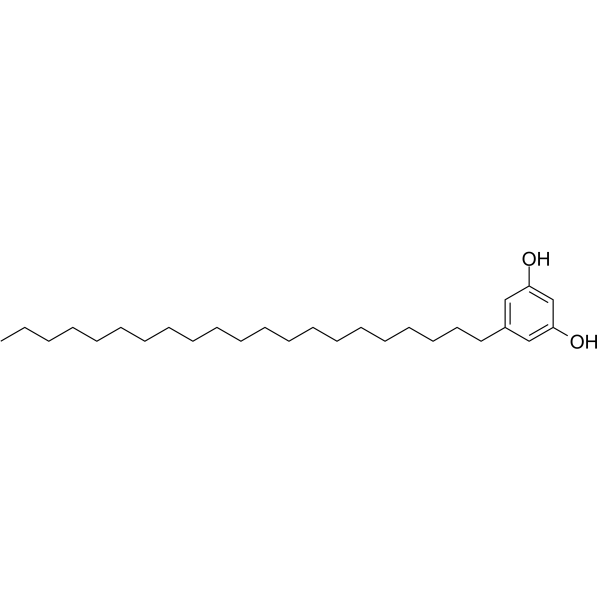
5-Heneicosylresorcinol
CAS No. 70110-59-7
5-Heneicosylresorcinol( —— )
Catalog No. M29269 CAS No. 70110-59-7
5-Heneicosylresorcinol shows inhibitory effects on the release of β-hexosaminidase from RBL-2H3 cells, it also prevents triglyceride accumulation in 3T3-L1 cells. 5-Heneicosylresorcinol has nematicidal activity against nematodes Panagrellus redivivus, Caenothabditis elegans and Bursaphelenchus xylophilus, with ED50 values of 80, 30, and 180 ug/mL, respectively.
Purity : >98% (HPLC)
 COA
COA
 Datasheet
Datasheet
 HNMR
HNMR
 HPLC
HPLC
 MSDS
MSDS
 Handing Instructions
Handing Instructions
| Size | Price / USD | Stock | Quantity |
| 5MG | 258 | In Stock |


|
| 10MG | 385 | In Stock |


|
| 25MG | 695 | In Stock |


|
| 50MG | 1032 | In Stock |


|
| 100MG | 1563 | In Stock |


|
| 200MG | Get Quote | In Stock |


|
| 500MG | Get Quote | In Stock |


|
| 1G | Get Quote | In Stock |


|
Biological Information
-
Product Name5-Heneicosylresorcinol
-
NoteResearch use only, not for human use.
-
Brief Description5-Heneicosylresorcinol shows inhibitory effects on the release of β-hexosaminidase from RBL-2H3 cells, it also prevents triglyceride accumulation in 3T3-L1 cells. 5-Heneicosylresorcinol has nematicidal activity against nematodes Panagrellus redivivus, Caenothabditis elegans and Bursaphelenchus xylophilus, with ED50 values of 80, 30, and 180 ug/mL, respectively.
-
Description5-Heneicosylresorcinol shows inhibitory effects on the release of β-hexosaminidase from RBL-2H3 cells, it also prevents triglyceride accumulation in 3T3-L1 cells. 5-Heneicosylresorcinol has nematicidal activity against nematodes Panagrellus redivivus, Caenothabditis elegans and Bursaphelenchus xylophilus, with ED50 values of 80, 30, and 180 ug/mL, respectively.(In Vitro):Alkylresorcinols are phenolic lipids present at levels of 0.03-0.15% in wheat and rye grains and almost 10 times higher in respective bran products. Despite numerous studies on the influence of dietary fibers on the regulation of energy metabolism, this issue still remains controversial. METHODS AND RESULTS: The objective of our current studies was to investigate whether 5-n-alk(en)ylresorcinols, natural phenolic components of high fiber human diets, may be considered as natural regulators of excessive fat accumulation. Our studies revealed that 5-n-alk(en)ylresorcinols isolated from wheat and rye bran inhibit glycerol-3-phosphate dehydrogenase, the key enzyme in triglyceride synthesis in adipocytes, specifically and effectively. Further in vitro studies showed that these compounds also prevent triglyceride accumulation in 3T3-L1 cells. CONCLUSIONS: The most effective compound in both systems was 5-n-heneicosylresorcinol(5-Heneicosylresorcinol). The results indicate that the potential to prevent triglyceride accumulation increases with the hydrophobicity of the phenolic inhibitor.
-
In Vitro——
-
In Vivo——
-
Synonyms——
-
PathwayMembrane Transporter/Ion Channel
-
TargetNADPH
-
RecptorNADPH
-
Research Area——
-
Indication——
Chemical Information
-
CAS Number70110-59-7
-
Formula Weight404.66
-
Molecular FormulaC27H48O2
-
Purity>98% (HPLC)
-
Solubility——
-
SMILESCCCCCCCCCCCCCCCCCCCCCc1cc(O)cc(O)c1
-
Chemical Name——
Shipping & Storage Information
-
Storage(-20℃)
-
ShippingWith Ice Pack
-
Stability≥ 2 years
Reference
molnova catalog



related products
-
ML-090
ML-090 is NOX1-specific inhibitor(IC50 = 90 nM) which is >100 selectivity for NOX1 over NOX2, NOX3, NOX4 (all IC50s >10 μM).
-
Protosappanin A
Protosappanin A has anti-oxidative/nitrative activities on brain immune and neuroinflammation through regulation of CD14/TLR4-dependentinflammation signal pathway.
-
Dicumarol
An oral anticoagulant that interferes with the metabolism of vitamin K. It is also used in biochemical experiments as an inhibitor of reductases.



 Cart
Cart
 sales@molnova.com
sales@molnova.com


